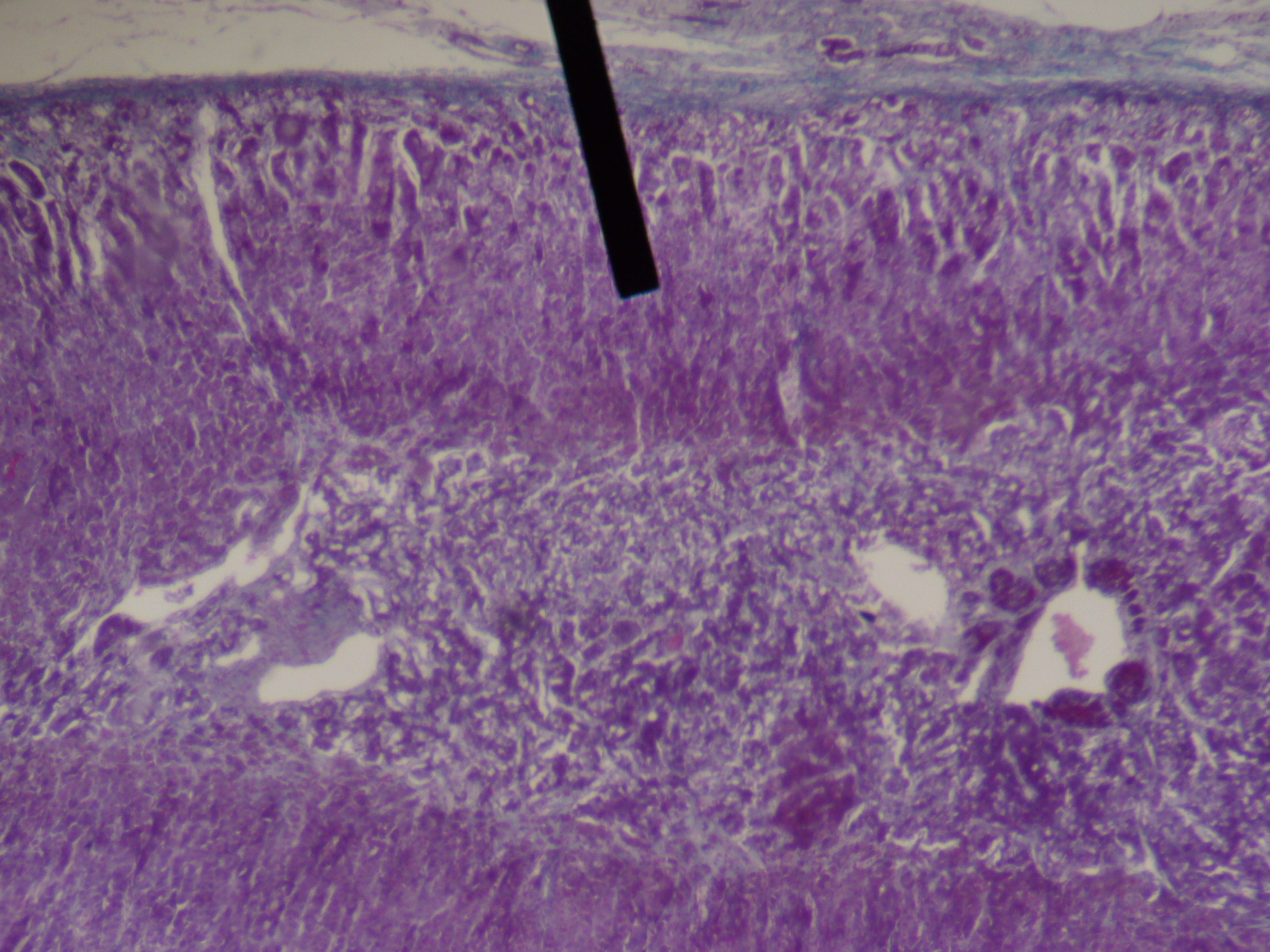Zona fasciculata on:
[Wikipedia]
[Google]
[Amazon]
The ''zona fasciculata'' (sometimes, fascicular or fasciculate zone) constitutes the middle and also the widest zone of the 
adrenal cortex
The adrenal cortex is the outer region and also the largest part of an adrenal gland. It is divided into three separate zones: zona glomerulosa, zona fasciculata and zona reticularis. Each zone is responsible for producing specific hormones. It ...
, sitting directly beneath the ''zona glomerulosa
The ''zona glomerulosa'' (sometimes, glomerular zone) of the adrenal gland is the most superficial layer of the adrenal cortex, lying directly beneath the renal capsule. Its cells are ovoid and arranged in clusters or arches (''glomus'' is Latin ...
''. Constituent cells are organized into bundles or "fascicles".
The ''zona fasciculata'' chiefly produces glucocorticoids
Glucocorticoids (or, less commonly, glucocorticosteroids) are a class of corticosteroids, which are a class of steroid hormones. Glucocorticoids are corticosteroids that bind to the glucocorticoid receptor that is present in almost every verte ...
(mainly cortisol
Cortisol is a steroid hormone, in the glucocorticoid class of hormones. When used as a medication, it is known as hydrocortisone.
It is produced in many animals, mainly by the '' zona fasciculata'' of the adrenal cortex in the adrenal g ...
in humans), which regulate the metabolism of glucose. Glucocorticoid production is stimulated by adrenocorticotropic hormone
Adrenocorticotropic hormone (ACTH; also adrenocorticotropin, corticotropin) is a polypeptide tropic hormone produced by and secreted by the anterior pituitary gland. It is also used as a medication and diagnostic agent. ACTH is an important ...
(ACTH), which is released from the anterior pituitary
A major organ of the endocrine system, the anterior pituitary (also called the adenohypophysis or pars anterior) is the glandular, anterior lobe that together with the posterior lobe ( posterior pituitary, or the neurohypophysis) makes up the ...
, especially in times of stress as part of the fight-or-flight response
The fight-or-flight or the fight-flight-or-freeze response (also called hyperarousal or the acute stress response) is a physiological reaction that occurs in response to a perceived harmful event, attack, or threat to survival. It was first desc ...
. The ''zona fasciculata'' also generates a small amount of weak androgen
An androgen (from Greek ''andr-'', the stem of the word meaning "man") is any natural or synthetic steroid hormone that regulates the development and maintenance of male characteristics in vertebrates by binding to androgen receptors. This in ...
s (e.g., dehydroepiandrosterone). The main source of androgens will come from the ''zona reticularis
The zona reticularis (sometimes, reticulate zone) is the innermost layer of the adrenal cortex, lying deep to the zona fasciculata and superficial to the adrenal medulla. The cells are arranged cords that project in different directions giving a ...
'' region. In certain animals such as rodents
Rodents (from Latin , 'to gnaw') are mammals of the order Rodentia (), which are characterized by a single pair of continuously growing incisors in each of the upper and lower jaws. About 40% of all mammal species are rodents. They are na ...
, the lack of 17alpha-hydroxylase results in the synthesis of corticosterone
Corticosterone, also known as 17-deoxycortisol and 11β,21-dihydroxyprogesterone, is a 21-carbon steroid hormone of the corticosteroid type produced in the cortex of the adrenal glands. It is of minor importance in humans, except in the very ra ...
instead of cortisol.
Steroid-producing adrenal tumours and hyperplasia
Hyperplasia (from ancient Greek ὑπέρ ''huper'' 'over' + πλάσις ''plasis'' 'formation'), or hypergenesis, is an enlargement of an organ or tissue caused by an increase in the amount of organic tissue that results from cell proliferati ...
of the ''zona fasciculata'' result in excess cortisol production and are the cause for adrenal Cushing's syndrome
Cushing's syndrome is a collection of signs and symptoms due to prolonged exposure to glucocorticoids such as cortisol. Signs and symptoms may include high blood pressure, abdominal obesity but with thin arms and legs, reddish stretch marks ...
. The genetic disorder
A genetic disorder is a health problem caused by one or more abnormalities in the genome. It can be caused by a mutation in a single gene (monogenic) or multiple genes (polygenic) or by a chromosomal abnormality. Although polygenic disorde ...
McCune-Albright syndrome can also present as Cushing's syndrome in affected patients.
See also
* SpongiocyteExternal links
* * - "Adrenal Gland" {{Adrenal gland Adrenal gland it:Zona fascicolata